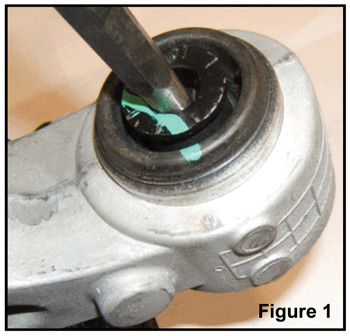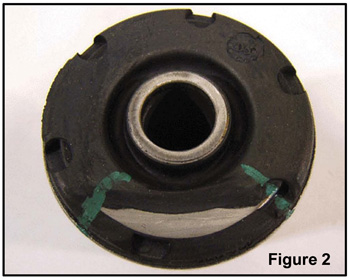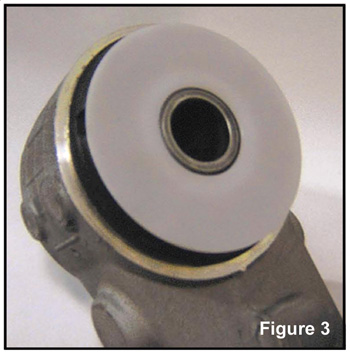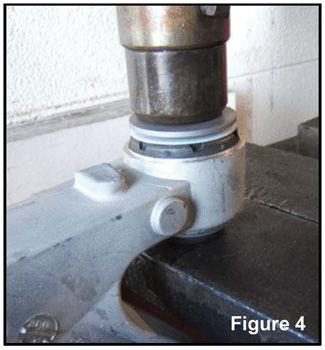By Chris Burton, ALLDATA Editor
and Jeff Webster, ALLDATA Technical writer
Parts Information
#19150047 Bumper Kit, Front Lower Control Arm
Repair Procedure
Diagnostic Tip: This noise can be isolated, as lubing or wetting the rear bushing will temporarily eliminate the noise. While this noise can be irritating, it poses no durability or functional concern.
Install a plastic insulating spacer between the rear control arm bushing and the rate washer using the following procedure. This plastic insulating spacer is part of the kit listed in Parts Information.
Spacers should only be used on old bushings that exhibit the metal-to-metal wear condition as pictured in Step 3. DO NOT use spacers on new parts or on lower mileage vehicles that do not have this wear condition or a squeak will result due to insufficient clearance.
1. Remove the front lower control arm using factory and/or industry standard approved practices.
2. Remove the rear bushing rate washer using a punch (Figure 1). Discard the washer.
 3. Inspect the bushing for tears. If there is any evidence of a torn bushing, DO NOT proceed with this bulletin. Replacement of the lower control arm is required.
3. Inspect the bushing for tears. If there is any evidence of a torn bushing, DO NOT proceed with this bulletin. Replacement of the lower control arm is required.
Scuff wear to the bushing is the condition this Tech Tip addresses (Figure 2).

4. Install the new insulating spacer onto the rear bushing (Figure 3).
5. Using an arbor press, install the new rate washer to the rear bushing (Figure 4). 
6. Reinstall the front lower control arm using factory and/or industry standard approved practices.
7. Repeat steps 1 through 6 for the other side of the vehicle.
8. Realign front suspension, then road test to verify repair.
Chris Burton is a double-certified ASE Master Tech in both automotive and body and paint. Chris is also a certified Chrysler Master Technician and certified Mazda Master Technician. He has been with ALLDATA for 16 years as an editor, production manager and senior software quality engineer. ©2010 ALLDATA LLC. All rights reserved.
Courtesy of ALLDATA.













